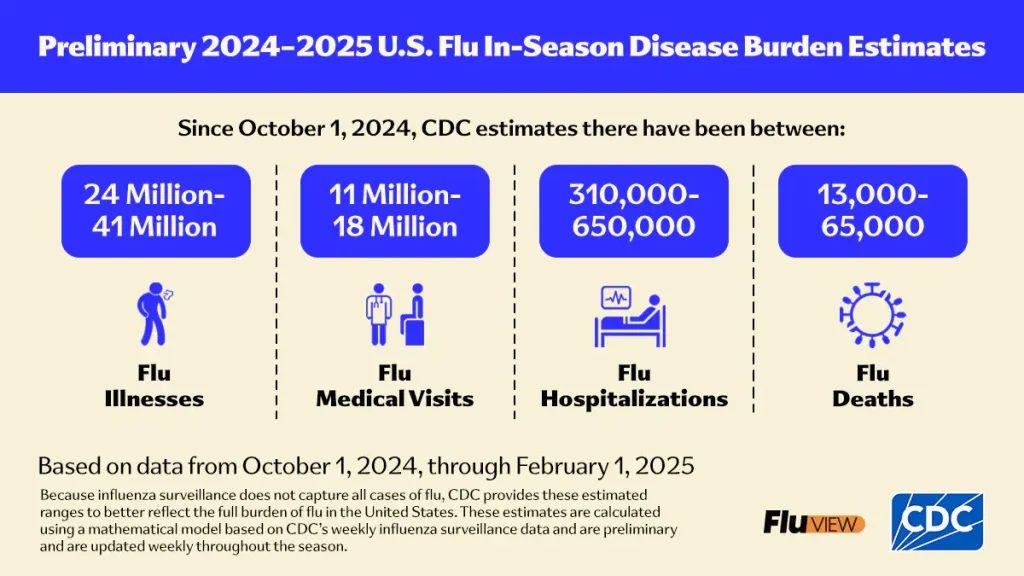The impact of influenza on public health remains significant, with the CDC’s preliminary estimates for the 2024-2025 flu season showing between 24-41 million illnesses and 13,000-65,000 deaths in the United States alone. These sobering statistics underscore the importance of understanding Influenza A vs B symptoms, as recognizing the differences between flu types can be crucial for proper treatment and potentially life-saving interventions.

When investigating flu symptoms, many people are surprised to learn that not all influenza viruses are created equal. With four distinct types of flu viruses – A, B, C, and D – it’s essential to focus on the two main types that significantly impact human health: Influenza A and B. These two types account for the majority of seasonal flu cases and understanding their unique characteristics can help you better navigate flu season.
Understanding the distinctions between Influenza A vs B symptoms becomes even more critical when we consider that these viruses affect different populations in various ways and can lead to different outcomes. As we dive into this comprehensive guide, you’ll discover why knowing these distinctions matters and how they affect your health journey during flu season.
The Key Differences Between Influenza A and B
The world of influenza is more complex than many realize. While you might hear about “the flu” as if it’s a single entity, there are actually several types, with Influenza A and B being the most significant for humans. Let’s explore what makes each type unique and how their symptoms can affect you differently.
Structural and Behavioral Differences
Influenza A vs B symptoms often stem from fundamental differences in their viral structure and behavior. Influenza A, accounting for approximately 75% of all flu cases, stands out with its remarkable ability to infect both humans and animals, including birds and pigs. This versatility contributes to its frequent mutations and widespread impact.
What makes Influenza A particularly noteworthy is its surface proteins, which can combine in various ways to create different strains like H1N1 and H3N2. This adaptability makes it more challenging for our immune systems to combat effectively. When you’re wondering which is worse, Influenza A or B, it’s important to note that Type A’s mutation capability often leads to more severe outbreaks and even pandemics.
In contrast, Influenza B exclusively affects humans and represents about 25% of flu cases. It’s divided into two main lineages: B/Yamagata and B/Victoria. While both types can cause seasonal epidemics, Influenza B typically shows up later in the flu season, often peaking during spring months.
Comparing Influenza A vs B Symptoms
When it comes to distinguishing what is the difference between Influenza A and Influenza B in terms of symptoms, the similarities can be striking. Both types typically present with:
- Fever ranging from 100-102°F with accompanying chills
- Intense headaches
- Significant muscle and body aches
- Pronounced weakness and fatigue
- Extreme exhaustion
- Respiratory symptoms including stuffy or runny nose
- Sore throat and sneezing
However, the severity and progression of these symptoms can vary between the two types. Influenza A symptoms often develop more aggressively and can be more severe in adults. Meanwhile, Influenza B, while generally causing milder illness in adults, can be particularly challenging for children under 5 and older adults.

Deep Dive into Influenza A
When examining Influenza A vs B symptoms in detail, understanding Type A’s unique characteristics becomes crucial for proper identification and treatment. Let’s explore why Influenza A often raises more concerns among healthcare providers and what this means for you.
Characteristics and Subtypes
Influenza A’s complexity becomes evident when we look at its subtypes, particularly H1N1 and H3N2. These variations, identified by specific ICD-10 codes for accurate medical recording, demonstrate why tracking Influenza A vs B symptoms is vital for both diagnosis and treatment. The influenza A virus ICD-10 classification helps healthcare providers document and track cases more effectively, especially during outbreak seasons.
What makes Type A particularly noteworthy is its ability to:
- Rapidly mutate and create new strains
- Cross species barriers (affecting both humans and animals)
- Cause more severe symptoms in many cases
- Spread more efficiently during peak seasons
High-Risk Groups and Complications
One of the most pressing concerns when dealing with Influenza A is its potential for complications. A common question is “can Influenza A turn into pneumonia?” The answer is yes – it can lead to serious complications, including pneumonia, particularly in high-risk individuals such as:
- Older adults
- Young children
- People with compromised immune systems
- Individuals with chronic health conditions
Understanding the infection timeline is crucial. Many people ask, “how long am I contagious with Influenza A?” The contagious period typically begins one day before symptoms appear and continues for up to seven days after becoming sick. This knowledge is essential for preventing transmission to others.
Deep Dive into Influenza B
Understanding Type B Flu
While comparing Influenza B vs A, it’s important to note that Type B shouldn’t be underestimated. Although it generally causes milder symptoms in adults, its impact on children can be significant. The B/Yamagata and B/Victoria lineages each have distinct characteristics that influence how the virus affects different age groups.
What sets Influenza B apart:
- More stable genetic structure
- Less frequent mutations
- Higher impact on children
- Later seasonal occurrence
When considering which influenza is worse, A or B, the answer isn’t straightforward. While Type A typically causes more severe symptoms in adults, Type B can be equally or more severe in children, making age a crucial factor in determining potential severity.

Frequently Asked Questions
Understanding Influenza A vs B symptoms leads to many common questions. Let’s address the most pressing concerns about diagnosis, prevention, and recovery to help you make informed health decisions.
Diagnosis and Testing
One of the most common questions is “is it influenza or a cold?” While both conditions share some symptoms, Influenza A vs B symptoms tend to be more severe and develop more suddenly than cold symptoms. Here’s what you need to know about testing:
- Rapid influenza diagnostic tests (RIDTs) can detect both types
- Results help determine appropriate treatment options
- Early testing leads to more effective treatment outcomes
Many people also ask about Influenza A in kids, as children often experience different symptom patterns. Testing becomes particularly important for young patients, as they’re more vulnerable to complications.
Prevention and Protection
A crucial consideration is how long can influenza live on surfaces. Studies show that:
- Influenza A can survive on surfaces for several hours to days
- The virus remains active longer on hard, non-porous surfaces
- Regular cleaning and disinfection are essential for prevention
When it comes to prevention, questions often arise about multiple infections. Can you get Influenza A twice? While it’s possible to contract different strains within the same season, having antibodies from one infection doesn’t protect against other strains or types.
Recovery and Contagion
Recovery timelines vary, but several factors influence the duration:
- Severity of initial symptoms
- Overall health status
- Age and immune system strength
- Proper rest and care during recovery
Some patients experience unusual symptoms, such as an influenza A rash, which might require additional medical attention. While less common, skin manifestations can occur during flu infections.

Immune-Supporting Supplements for Flu Prevention
When exploring strategies to combat Influenza A vs B symptoms, many people consider dietary supplements as part of their prevention toolkit. While it’s crucial to understand that no supplement can prevent or cure the flu – vaccination remains the most effective preventive measure – certain supplements may help support your immune system during flu season.
Vitamin C
This essential antioxidant plays a vital role in supporting immune function. While Vitamin C supplements are widely available, you can also boost your intake through natural sources like:
- Citrus fruits (oranges, lemons, grapefruits)
- Bell peppers
- Leafy green vegetables
- Strawberries
- Broccoli
Vitamin D
Often called the “sunshine vitamin,” Vitamin D is crucial for immune health and may help reduce the risk of respiratory infections. During flu season, which often coincides with shorter daylight hours, many people may benefit from supplementation since natural production through sunlight exposure decreases.
Zinc
This mineral plays a fundamental role in immune cell development and function. You can increase your zinc intake through:
- Lean meats
- Shellfish
- Legumes
- Seeds and nuts
- Whole grains
Echinacea
This traditional herb has been used for centuries to support immune health. While research results vary, some studies suggest it may help stimulate immune system function. As with any supplement, it’s important to:
- Choose high-quality products
- Follow recommended dosages
- Consult with healthcare providers before starting supplementation
- Be aware that it may interact with certain medications
Remember that while these supplements may support your immune system, they should never replace primary prevention methods such as vaccination and proper hygiene practices. Always consult with your healthcare provider before starting any supplement regimen, especially if you’re taking other medications or have underlying health conditions.

Essential Prevention and Treatment Strategies
Prevention Methods
The best defense against both types of flu includes:
- Annual vaccination
- Regular hand washing
- Avoiding close contact with infected individuals
- Maintaining good overall health
- Proper cleaning of frequently touched surfaces
Vaccination Timing and Recommendations
Timing is crucial when it comes to flu vaccination strategy. For optimal protection against both Influenza A vs B symptoms, the vaccination window matters significantly. Dr. Robert Hopkins, Jr., medical director for the National Foundation for Infectious Diseases, recommends getting the flu vaccine between mid-September and early October, particularly for older adults and those with chronic medical conditions. This timing ensures immune protection throughout the entire flu season.
The CDC has specific recommendations for different age groups and risk levels. For older adults, the guidance is clear: higher-dose flu vaccines or adjuvanted inactivated flu vaccines are preferred over standard-dose unadjuvanted versions. These enhanced vaccines provide:
- Stronger immune response
- Better protection against both flu types
- More effective defense for those with less robust immune systems
By understanding these key aspects of Influenza A vs B symptoms, you’re better equipped to recognize, prevent, and respond to flu infections. Remember that while this information provides general guidance, consulting with healthcare professionals for specific medical advice is always recommended, especially for high-risk individuals or severe cases.



